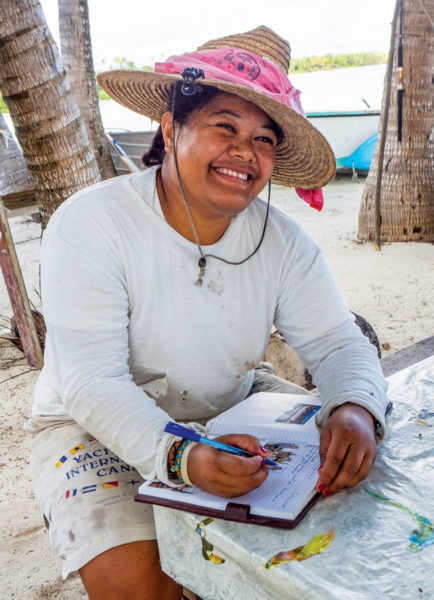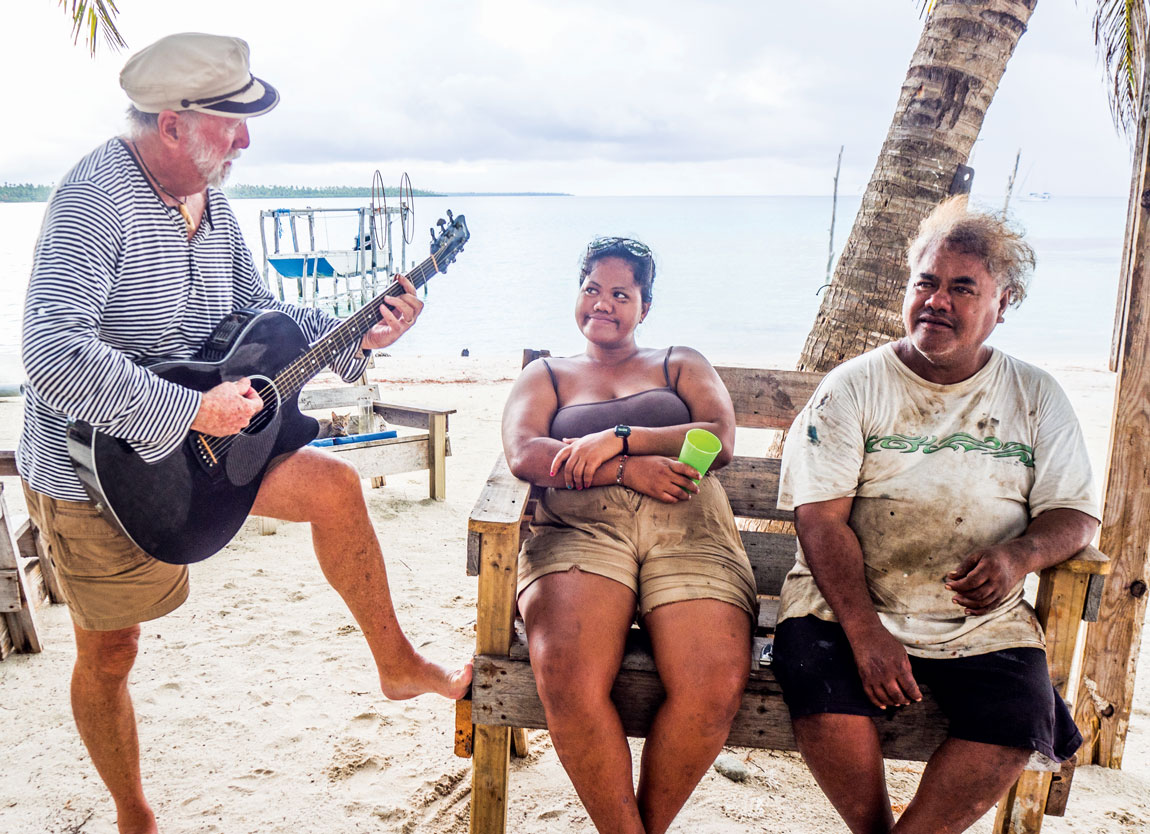Many Pacific cruisers dismiss the Society Islands because Tahiti is so developed.
This is silly—like refusing to visit the Grand Canyon because NYC has traffic jams.
Take Maupiha’a, the westernmost inhabited isle for example. (Also spelled Mopelia on some maps.) It is still paradise-on-earth for all 12 of its Polynesian inhabitants.
Why? Well, one reason is that, while the lagoon is huge, the land mass is miniscule. Equally discouraging is its remoteness from Bora Bora. Another factor is the lack of freshwater. Plus, there’s no dock—let alone an airport. And even legal-eagle yachts don’t visit regularly because, theoretically, you’d have sail back to windward to Ra’iātea to clear out. (We’re happy to point out we’re not legal-eagles.)
There are other navigational factors as well. The problem isn’t that the narrow and long pass is reef-strewn and only 50 feet wide—but rather that the current (and its accompanying eddies) can run at 9 knots plus. Thus, safe entrance can only be attempted at dead high water with the sun high over your shoulder.
Yes, the five-mile wide lagoon (20 square miles) has a long fetch and is dotted with a million coral heads. That’s the bad news. The good news is that it is teaming with lobsters, oysters, and fish. Living off the land is easy here—bird eggs, land crabs, and coconuts offer themselves up everywhere. (Note: always ask before harvesting anything ashore in Polynesia, as someone owns each blade of grass. The locals are extremely generous—but also have strict cultural rules.)

Waterborne visitors are warmly welcomed in this part of the world—and not just out of boredom.
The few inhabitants are desperate for news—and grateful to trade anything they have for spices, fishing gear, and chocolate.
We immediately fell in with Marcello and his family. He’d been farming copra (dried coconut) there for 8 years. His wife Adrienne would start boiling a tasty land crab the moment she’d observe us beginning to pull our dinghy towards our transom to come ashore. And his daughters Faimana and Karina loved to sing with us when I brought my Rainsong guitar to the beach.
They were a lovely, super-close family—hardworking, rugged, and creative in their own hardscrabble way. Their ramshackle house was mostly built out of flotsam and jetsam—and the wreckage of passing yachts. (The island is low, steep-to, and ill-lit.)
The daughters, Karina and Faimana, share a dream to visit Machu Picchu in Peru. They are always attempting (unsuccessfully) to hitchhike aboard a yacht to Easter Island—which, in their skewed worldview, is nearly the same place.
Odd? Of course! That’s why we are on our 59th year of living aboard and traveling—because we covet odd, strange, and weird people living in the remotest corners of the world.

It was here in Paradise where I suffered by first shark attack—which I fended off with my walking stick.
…yes, another odd story.
I was circumnavigating nearby Aveu on foot one afternoon for exercise—when an outcropping of rocks forced me to wade around them. While doing so, I paused to observe an inquisitive baby shark. The lagoon is full of sharks. We swim together all the time without problem. But now this particular shark was only seeing my lower legs and feet—and thus attacked aggressively.
I was shocked—and reacted instinctively by defending myself with my walking stick. The three-foot shark came at me fast and I bided my time before poking it hard on the snout. It immediately swam away—shocked to be attacked back from the surface.
I thought the danger was over but I was wrong. After swimming away about 70 or 80 feet, the shark turned back and streaked towards me with great speed and force. While it was small for a shark, it was big for a fish. And it had a gaping mouth with rows of extremely sharp teeth. I had no time to dash onto the beach. So I tried to poke it again—only this time it was more determined.
Finally I managed to pin it down onto the sand as it thrashed eagerly to get a taste of my ankles—yikes!
How did I manage to get ashore without being bitten? I’m not sure. Perhaps I walked on water? Or did I just scream myself ashore?
All I know is that the locals heard me miles away.

The father, Marcello, was a bit of a Renaissance Man.
He could fish, butcher wood, repair diesel engines—and knew enough about electricity to salvage some old solar panels. In addition, he was mini-leader of the union of his fellow local leaseholders—the government of French Polynesia allowed the group to legally live/work here IF they followed certain rules and harvested so much copra (dried coconut kernels) annually.
Marcello didn’t own a clock—nor feel in need of one. Ditto, a lock. Karina and Faimana didn’t have much formal education—nor were they convinced of its importance. Adrienne had everything she needed—as long as her cupboard was filled with purged land-crabs, husked coconuts, and dried fish. (There were so many nesting birds on the island that we had to be very careful where to step—otherwise we’d crush a newly-laid egg.
Marcello and his family were wonderful hosts—to both us and their fellow copra growers. While they would often work from sun up until sun down, if anyone visited they’d immediately shift into party-mode.
Often they’d go months without a yacht in the lagoon—but ‘in season’ during August and September there might be three to five yachts illegally ‘pausing’ on passage between the Societies and the Cook Islands to the west.

How long did we stay?
We’re not sure. Glancing at a calendar seemed against the cosmic spirit of the place. But one of the reasons we finally left was because we felt our hosts might be giving us too much of their precious resources—they had nothing and yet were constantly urging us to take it all.
How can such isles—and such generous people—still exist?
The Pacific is a big, vast, culturally-diverse ocean. Not everywhere is paved over in Paradise—not yet, anyway.
Perhaps best of all, most South Pacific islanders are totally off-the-grid and sans Internet. They are happy because they have no reason not to be.
Wise, eh?
Top 10 Must-Visit Spots in Guatemala’s Rio Dulce for Cruisers
Carolyn and Fatty are currently hauled out in New Zealand. Their next destination is French New Caledonia—for a croissant and baguette fix.





